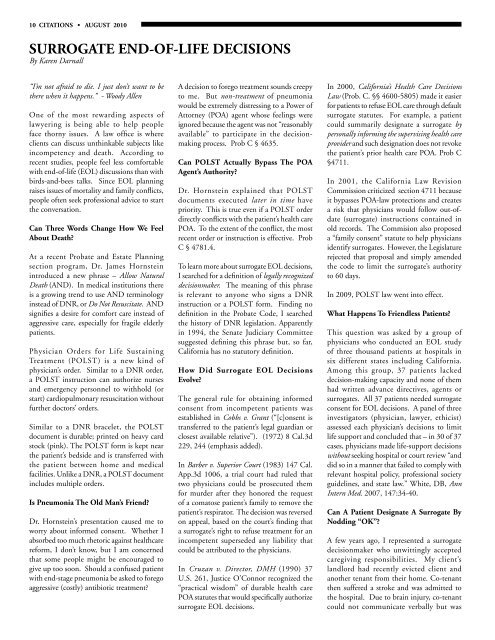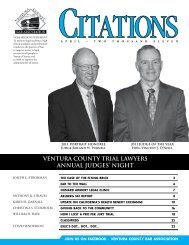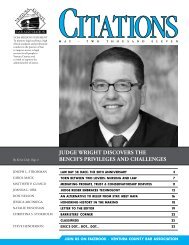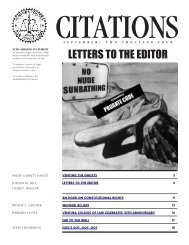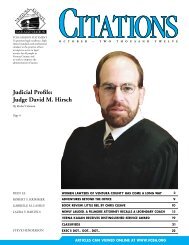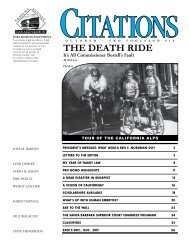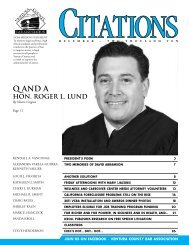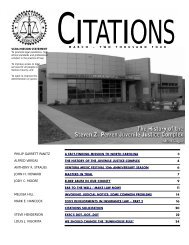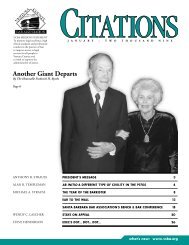ALERT: FILING PROCEDURE CHANGED - Ventura County Bar ...
ALERT: FILING PROCEDURE CHANGED - Ventura County Bar ...
ALERT: FILING PROCEDURE CHANGED - Ventura County Bar ...
You also want an ePaper? Increase the reach of your titles
YUMPU automatically turns print PDFs into web optimized ePapers that Google loves.
10 CITATIONS • AUGUST 2010<br />
SURROGATE END-OF-LIFE DECISIONS<br />
By Karen Darnall<br />
“I’m not afraid to die. I just don’t want to be<br />
there when it happens.” - Woody Allen<br />
One of the most rewarding aspects of<br />
lawyering is being able to help people<br />
face thorny issues. A law office is where<br />
clients can discuss unthinkable subjects like<br />
incompetency and death. According to<br />
recent studies, people feel less comfortable<br />
with end-of-life (EOL) discussions than with<br />
birds-and-bees talks. Since EOL planning<br />
raises issues of mortality and family conflicts,<br />
people often seek professional advice to start<br />
the conversation.<br />
Can Three Words Change How We Feel<br />
About Death<br />
At a recent Probate and Estate Planning<br />
section program, Dr. James Hornstein<br />
introduced a new phrase – Allow Natural<br />
Death (AND). In medical institutions there<br />
is a growing trend to use AND terminology<br />
instead of DNR, or Do Not Resuscitate. AND<br />
signifies a desire for comfort care instead of<br />
aggressive care, especially for fragile elderly<br />
patients.<br />
Physician Orders for Life Sustaining<br />
Treatment (POLST) is a new kind of<br />
physician’s order. Similar to a DNR order,<br />
a POLST instruction can authorize nurses<br />
and emergency personnel to withhold (or<br />
start) cardiopulmonary resuscitation without<br />
further doctors’ orders.<br />
Similar to a DNR bracelet, the POLST<br />
document is durable; printed on heavy card<br />
stock (pink). The POLST form is kept near<br />
the patient’s bedside and is transferred with<br />
the patient between home and medical<br />
facilities. Unlike a DNR, a POLST document<br />
includes multiple orders.<br />
Is Pneumonia The Old Man’s Friend<br />
Dr. Hornstein’s presentation caused me to<br />
worry about informed consent. Whether I<br />
absorbed too much rhetoric against healthcare<br />
reform, I don’t know, but I am concerned<br />
that some people might be encouraged to<br />
give up too soon. Should a confused patient<br />
with end-stage pneumonia be asked to forego<br />
aggressive (costly) antibiotic treatment<br />
A decision to forego treatment sounds creepy<br />
to me. But non-treatment of pneumonia<br />
would be extremely distressing to a Power of<br />
Attorney (POA) agent whose feelings were<br />
ignored because the agent was not “reasonably<br />
available” to participate in the decisionmaking<br />
process. Prob C § 4635.<br />
Can POLST Actually Bypass The POA<br />
Agent’s Authority<br />
Dr. Hornstein explained that POLST<br />
documents executed later in time have<br />
priority. This is true even if a POLST order<br />
directly conflicts with the patient’s health care<br />
POA. To the extent of the conflict, the most<br />
recent order or instruction is effective. Prob<br />
C § 4781.4.<br />
To learn more about surrogate EOL decisions,<br />
I searched for a definition of legally recognized<br />
decisionmaker. The meaning of this phrase<br />
is relevant to anyone who signs a DNR<br />
instruction or a POLST form. Finding no<br />
definition in the Probate Code, I searched<br />
the history of DNR legislation. Apparently<br />
in 1994, the Senate Judiciary Committee<br />
suggested defining this phrase but, so far,<br />
California has no statutory definition.<br />
How Did Surrogate EOL Decisions<br />
Evolve<br />
The general rule for obtaining informed<br />
consent from incompetent patients was<br />
established in Cobbs v. Grant (“[c]onsent is<br />
transferred to the patient’s legal guardian or<br />
closest available relative”). (1972) 8 Cal.3d<br />
229, 244 (emphasis added).<br />
In <strong>Bar</strong>ber v. Superior Court (1983) 147 Cal.<br />
App.3d 1006, a trial court had ruled that<br />
two physicians could be prosecuted them<br />
for murder after they honored the request<br />
of a comatose patient’s family to remove the<br />
patient’s respirator. The decision was reversed<br />
on appeal, based on the court’s finding that<br />
a surrogate’s right to refuse treatment for an<br />
incompetent superseded any liability that<br />
could be attributed to the physicians.<br />
In Cruzan v. Director, DMH (1990) 37<br />
U.S. 261, Justice O’Connor recognized the<br />
“practical wisdom” of durable health care<br />
POA statutes that would specifically authorize<br />
surrogate EOL decisions.<br />
In 2000, California’s Health Care Decisions<br />
Law (Prob. C. §§ 4600-5805) made it easier<br />
for patients to refuse EOL care through default<br />
surrogate statutes. For example, a patient<br />
could summarily designate a surrogate by<br />
personally informing the supervising health care<br />
provider and such designation does not revoke<br />
the patient’s prior health care POA. Prob C<br />
§4711.<br />
In 2001, the California Law Revision<br />
Commission criticized section 4711 because<br />
it bypasses POA-law protections and creates<br />
a risk that physicians would follow out-ofdate<br />
(surrogate) instructions contained in<br />
old records. The Commision also proposed<br />
a “family consent” statute to help physicians<br />
identify surrogates. However, the Legislature<br />
rejected that proposal and simply amended<br />
the code to limit the surrogate’s authority<br />
to 60 days.<br />
In 2009, POLST law went into effect.<br />
What Happens To Friendless Patients<br />
This question was asked by a group of<br />
physicians who conducted an EOL study<br />
of three thousand patients at hospitals in<br />
six different states including California.<br />
Among this group, 37 patients lacked<br />
decision-making capacity and none of them<br />
had written advance directives, agents or<br />
surrogates. All 37 patients needed surrogate<br />
consent for EOL decisions. A panel of three<br />
investigators (physician, lawyer, ethicist)<br />
assessed each physician’s decisions to limit<br />
life support and concluded that – in 30 of 37<br />
cases, physicians made life-support decisions<br />
without seeking hospital or court review “and<br />
did so in a manner that failed to comply with<br />
relevant hospital policy, professional society<br />
guidelines, and state law.” White, DB, Ann<br />
Intern Med. 2007, 147:34-40.<br />
Can A Patient Designate A Surrogate By<br />
Nodding “OK”<br />
A few years ago, I represented a surrogate<br />
decisionmaker who unwittingly accepted<br />
caregiving responsibilities. My client’s<br />
landlord had recently evicted client and<br />
another tenant from their home. Co-tenant<br />
then suffered a stroke and was admitted to<br />
the hospital. Due to brain injury, co-tenant<br />
could not communicate verbally but was


